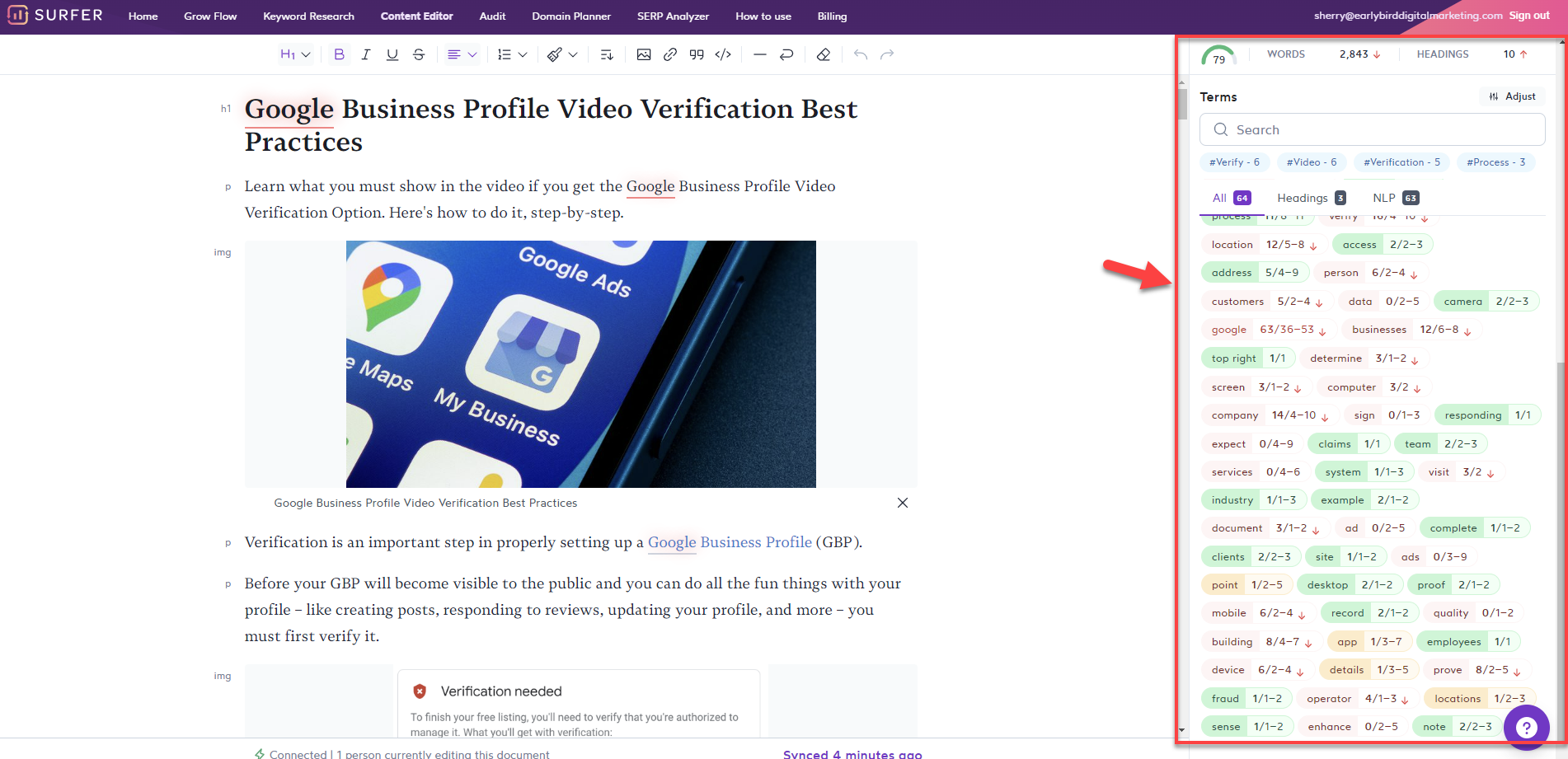SEO
8 Content Writing Tips From Experts In 2023

The digital market is volatile and ever-changing.
Everyone is competing for popular keywords, and artificial intelligence is changing content creation.
It can be a bit daunting, especially if you’re new to content writing.
So, how can you cut through the noise and write more effective content in 2023?
We’ve asked 17 industry professionals to share the wisdom they’ve learned over the years, their advice to those trying to find their way into content marketing, and their favorite tools for writing and optimization.
Julia McCoy, VP of Marketing at Content at Scale, would have told her younger self to realize the opportunity.
“It was hard to see it back then since I was at ground zero,” recalls McCoy.
“But the industry of content marketing itself had ballooned by billions of dollars since when I started. This would have given me more hope and excitement that what I did truly mattered to building not just income, but a legacy.”
Without further ado, here are their top tips:
1. Focus On Your Audience
Jamie Press, Digital Marketing Specialist At Eurisko
The best tip I can give a copywriter is to think “audience first.” This advice is straight from Brian Clark, founder of Copyblogger.
Sometimes, we go straight for the keyword tools when we’re brainstorming a piece of content; however, if we don’t know who we’re writing for, our copy won’t resonate with the reader.
Dialing into our target audience and their pain points (specific problems our audience needs solving) is the first step.
Carlijn Postma, Brand Strategist, Speaker, and Author of “Binge Marketing”
One: Start bingeing.
Really? Yes. The first educational go-to database is your streaming service.
The best writers and content creators are the creators of films and series. They know how to attract and retain an audience by creating a compelling story.
And bring your notebook.
Two: Know the difference between a target group and an audience.
In content marketing, your goal is to communicate through text, video, or audio. Therefore, you need readers, viewers, and listeners. That is an audience.
There is a huge difference between a target group and an audience.
A target group is pointed out by you as the sender of the content (whether this target group likes it or not).
An audience decides for itself if it wants to be your audience. I prefer to reach and engage an audience over a target group.
Focusing on an audience will make you a better writer.
 Image credit: Carlijn Postma, January 2023
Image credit: Carlijn Postma, January 2023Three: Always create content in series.
Now, if your goal is to attract and retain a loyal audience, you have to start creating content in series.
With only one episode, one piece of content, you just won’t be able to build an audience.
And if you are creating a series, learn from the masters: use cliffhangers at the end, and recaps at the start of an episode.
Ask yourself: “What does my audience need to know about what I wrote in previous episodes to understand this one?” This signals your audience to consume the other episodes, too.
Linda Pophal, Founder At Strategic Communications, LLC
Focus on your audience and their needs and interests – that’s all that really matters.
If you write for your audience and work to address the questions they might have, you will automatically create SEO-friendly content, because that’s what SEO is all about.
Even when my clients have specific SEO requirements, I first write the copy as I had always written it, long before SEO existed – to meet my audiences’ needs.
Then I’ll go back and “retrofit” the keywords that clients have requested; often, they’re already there and may just need to be tweaked or added to a bit.
2. Choose Quality Over Optimization
Steph Andrusjak, SEO Consultant
Always write with the user in mind, even when optimizing for search engines.
You can optimize an article by using keyword tools, like KeywordTool.io or AlsoAsked, to find what queries people are searching to help you mold your article – but don’t let the quest for optimization undo the quality of your writing.
If you’re writing content to sell something, then embrace copywriting formulas to create compelling statements.
If you’re writing articles of interest, then write in a way that the end user can relate to and explain the subject as fully as possible.
Most of all, write for your audience.
If your end users are teenagers, write in a style that will appeal to them without sacrificing the image you want to present.
If the website’s main customers are business owners, then opt for a more professional, formal tone.
Making sure your content is search engine optimized doesn’t necessarily mean you have to write thousands of words.
The key is that it needs to be as long as required for you to explain your point clearly and comprehensively. This means that content can be just as effective by writing concisely.
3. Build Out Your Content With Search Intent In Mind
Rudy Mawer, CEO At Mawer Capital
When you are just beginning your career in SEO writing, don’t forget that you write for both Google and the people who use it.
Keep these two equally important audiences in mind to maximize visibility and reach.
Quality content is essential, and Google knows this. It is pushing your content out to the world through its platform.
The better content that Google provides its users, the more likely people will use Google when they have a question.
It is essential to understand the keywords you are writing for and be able to talk about them dynamically.
You want your writing to be engaging, informative, and relevant for the reader.
Adam Berry, SEO Consultant At Adam Berry SEO 
I would definitely urge my former self to write for humans, not robots!
I’ve learned that it’s important to take the time to craft meaningful sentences that are interesting and engaging to readers.
This means writing with more details and facts to provide context, as well as aiming for greater semantic richness.
For example, instead of simply stating a fact or opinion, try elaborating on why it’s true, or how others may feel about it, to draw readers in.
By taking this approach, I found that readers were more likely to connect with my content and leave feeling enriched by the experience.
Joe Karasin, CMO At CircleIt And Head Of Growth Marketing At DigitalWill.com
One: Don’t let the new focus on AI-driven content deter you.
AI content may get technical points and be produced more quickly, but creating compelling content is something that is still a human endeavor.
At the end of the day, the search intent of most users will favor the content that holds interest, which as of right now, AI hasn’t shown it can do.
Two: Balance is key.
You might be able to craft a beautiful story with your content, but if it isn’t written with SEO in mind, it won’t rank.
However, if you write a bunch of SEO-friendly content that is boring, no one will want to read it, and it won’t rank.
Being focused on the balance is the way you will gain readers and traction in your career.
Three: Write about what people want to read.
If you are writing content for a company, you want to look at the real-life applications of the company’s products and services.
By putting the customer or reader in the central piece of your narrative, you will get others to read it and identify with the “hero” of your story.
For example, if you have created a new technology, don’t just write a post about the features. Talk about the users and how the features you want to write about are improving their lives.
Sherry Bonelli, Owner Of Early Bird Digital Marketing
If you are just starting in the writing industry, I first recommend following Ann Handley and getting a copy of her “Everybody Writes” book.
Ann is an amazing writer that gives you writing tips that you can use whether you’re tasked with writing blog posts, website content, email newsletters, social media posts, ads – or anything in between. Plus, she has a great sense of humor – so she’ll make you laugh as you learn to be a better writer!
Now, when I began my writing career, I was very lucky to have a solid SEO foundation under my belt.
But looking back, I focused too much on writing for individual keywords when I should’ve spent more time writing about the topics people were searching for.
As a writer, create content about the topics people are searching for and then do more extensive keyword research about the questions people ask about the topic (and subtopics) you’re writing about.
Make sure you answer those questions thoroughly in your content. That’s the way to make your readers – and Google – happy!
4. Consider Using AI Writing Tools, But Use Them Wisely
Julia McCoy, VP Of Marketing At Content At Scale
We live in a completely new era versus the one I started in.
Today, the baseline of human content production can be assisted, if not nearly replaced, by AI tools built on top of OpenAI’s game-changing GPT language releases to write and create content.
With GPT4 on the horizon and about to launch, human content production will shift forever into an AI-assisted one.
That said, if you’re considering a writing career, don’t think there’s no need for the human. There’s a huge need for your writing skills.
It will just look different than when I started – when it was solely human-based.
My tips for you: Learn how to incorporate AI writing tools into your process. Learn how to edit, cut the fluff, and make the content that AI produces better. Learn strategy.
These skills will put you in a place where you cannot be replaced by AI.
Cai Ellis, SEO Manager At ToolTester
Now is not the time to completely move over to AI writing tools.
Although Google hasn’t come out and said that AI content is bad, we know that it prefers content that’s written by people for people.
With that said, it wouldn’t hurt to learn how to optimize AI content so that it’s a skill you can call on as and when needed.
We will likely see this as something that’s specifically needed from marketers in no time.
You could have a trial run of ChatGPT at home, focusing on the creation of content that’s helpful and user-first using the tool’s text as a starting point.
Other than that, the number one lesson for any new writer would have to be not to put themselves under too much pressure.
It takes time to learn how to craft the types of content that will engage and persuade.
It’s advisable to keep writing as a side hustle until you’re confident of meeting and exceeding client expectations.
Shubham Bajaj, Founder And SEO Scientist At Netsurge Technologies
With the onset of various AI writing tools and ChatGPT, it’s important for content writers who are just getting started to be able to write in a way that differentiates them from machines.
Adding your personality and character to your write-up and telling engaging stories that can keep the reader hooked are important aspects.
It is also important to note that, while it’s good to be quirky and conversational, make sure you have an NLP-friendly section that defines or provides an exact answer for the query in a format that Google or other search engines can directly use to display as a snippet.
5. Practice Writing Regularly
Jason Hennessey, Founder And CEO At Hennessey Digital
Read widely and often to develop your writing skills and understand the various styles and forms of writing.
Then write every day, even if it’s just for a few minutes, to improve your writing discipline and practice your craft.
Lastly, seek feedback on your writing from others, and be open to constructive criticism.
Alex Valencia, President At We Do Web Content
If I could give my past self a piece of advice, it’d be to brush up on grammar and style rules.
For style, there’s nothing better than reading works by your favorite authors. How do they describe everyday things and situations? How do they craft sentences? What about their storytelling that hooks you in?
Then, practice, practice, practice.
Sam Hollingsworth, SEO Director At Moving Traffic Media
Write more often and be less scared.
Like so many other things, we get better at writing the more that we do it (and reading).
It allows us to learn new things, experiment with new processes, and expand our skills for everything from creativity to accuracy and even speed and efficiency.
Dvir Ben-Aroya, Co-Founder And CEO At Spike
For those just getting started in their writing careers, reading widely can help you develop a strong writing style.
By reading various authors and genres, you can learn about different writing techniques and styles and find inspiration for your own writing.
Practicing regularly is also important, as it allows you to improve your skills and become more proficient in your craft.
Networking with other writers can also be beneficial, as it can help you learn about the industry, find potential collaborators or mentors, and stay informed about new opportunities.
And it’s also important to be open to constructive criticism because it helps improve your writing.
Rudy Mawer, CEO At Mawer Capital
If I could go back to the beginning of my writing career, I would tell myself that I need to spend more time reading and practicing different types of writing.
Even if you only write one specific style of writing, practicing different styles and formats of writing will strengthen your primary style by association.
It is a great mental exercise to sharpen and use the other “tools” in your writing toolbox.
For example, if you only write B2B long-form keyword-rich blog content, practicing creative writing every so often might be useful.
By doing so, you can combat writer’s block, gain additional perspectives, and have more engaging and dynamic content.
6. Find Your Rhythm And Style That Sparks Joy
Alex Valencia, President At We Do Web Content
When starting a career as a writer, it’s critical to uncover the type of writing that brings you joy.
The topics you cover should excite you, and crafting pieces should feel like a privilege.
It shows in your work when you have passion for the things you’re writing about. The energy is relaxed and confident.
Jason Hennessey, Founder And CEO At Hennessey Digital
Focus on developing your own unique voice and style.
Writing is a highly personal and subjective endeavor, and it’s important to find your own way of expressing yourself and telling stories.
This will set your work apart and make it more likely to resonate with readers.
Sam Hollingsworth, SEO Director At Moving Traffic Media
Never forget that writing is (seemingly) one of the most basic ways for humans to communicate.
Of course, like most everything in life, there are good and bad examples of it.
Be mindful of the foundational guidelines we’ve been told most of our lives but also do not lose out on creativity to do so.
I often think back to something one of my favorite journalism professors taught me (and of which he claimed one of his favorite professors taught him as a budding journalist): “Write like jazz.”
It should have rhythm, but also irregularities and improvisation that allow it to stand out. It should be enjoyable and digested with ease.
7. Learn To Overcome Setbacks And Imposter Syndrome
Kaitie Frank, Digital Marketing Copywriter At Page One Power

Imposter syndrome is real. Kick it out the door and have confidence in your writing!
Read examples of great work, then put your spin on it.
Also, triple edit:
- Edit on-screen.
- Print it out and edit.
- Have another set of eyes look at it.
Don’t let people bully you into submission. I spent too much time at a job where I was told I wasn’t good enough, and that made me lose confidence in my writing.
Instead, find a place where mentors help you grow and develop your skills, not knock you down because you don’t write exactly like them.
Dvir Ben-Aroya, Co-Founder And CEO At Spike
If I could go back to the beginning of my writing career, I would advise myself to be more persistent.
Writing is a challenging and competitive field, and it can take a lot of time and effort to succeed.
It’s important not to give up too easily and to keep working towards your goals, even when faced with rejection or setbacks.
8. Grow Your Network And Portfolio
Monika Nozinic, Copywriter at Async Labs
My advice to those who are just getting started in their writing careers would be:
- Read and study as much as you can. Look at the work of famous copywriters and see what you can learn from them.
- Write every day to develop your skills and build a writing routine. The more you write, the better you’ll get at it.
- Get feedback. Show your work to other people and see what they think.
- Learn SEO. Understanding SEO will help you to write copy that ranks well in search engines.
- Network with other writers and industry professionals.
- Know your audience. Understand who you’re writing for and what they need.
- Be adaptable. Copywriting constantly evolves, so be prepared to learn new things and adapt to new trends.
- Practice makes perfect. Keep practicing and experimenting until you find your voice and style.
- Learn about the industry you’re writing for. This way, you’ll be able to understand their language and speak to their pain points and goals.
- Be passionate. Copywriting is a creative field, so bring your passion for working, and it will shine through in your writing.
The advice I would now give myself at the start of my career would be to connect with other copywriters and content creators. Ask them to be my mentor for a week or two.
Also, I would tell myself to develop thicker skin and persistence, as rejection and criticism are a normal part of the writing process, which I learned, sometimes the hard way, along the way.
Adam Berry, SEO Consultant At Adam Berry SEO
Take time to build your portfolio.
You’ll want to start collecting samples of your work as soon as possible; these will be invaluable when applying for jobs or searching for opportunities.
Make sure each piece is polished and showcases your best writing ability.
Experts’ Favorite Tools For Content Writing And Optimization
Grammarly And Hemmingway
Alex Valencia’s top writing tool is Grammarly, and he says that “every professional should use it (#notanad).”
“It’s taught me a lot about my writing style and how to improve it. For keyword research, I use Semrush,” Valencia shares.
Shubham Bajaj suggests Grammarly and Hemingway “for avoiding grammatical errors and ensuring that your content is structured properly, especially when starting and you have a low to zero budget to spend on tools.”
“Once you have some budget to spend, consider subscribing to advanced tools like ProWritingAid,” Bajaj recommends.
Surfer SEO
“When it comes to writing tools, there are oodles of SEO tools out there that have content tools built in. (Some are definitely better than others.) One of my favorite tools for optimizing content is Surfer SEO,” says Sherry Bonelli.
“Surfer SEO takes the keyword you’re trying to optimize your content for and analyzes your content against the top-ranking webpages.
Then it shows All words and Natural Language Process (NLP) words so you can see if you’re overusing some words – or not using words that you perhaps should use. (Like maybe you didn’t even think about including a word or topic in what you were writing!)
Surfer SEO can really take your writing optimization to the next level. I’d highly recommend you play around with it.”
 Screenshot from Surfer SEO, modified by author, January 2023
Screenshot from Surfer SEO, modified by author, January 2023“Don’t be afraid to use tools to your advantage,” advises Rudy Mawer.
“You are writing search engine-centric content; the internet has many resources and tools to help make your job easier and your writing more effective.”
Mawer loves using Surfer SEO as well. “Its content editor gives you a real-time score of your content’s strength for the keyword you are trying to rank for, NLP keyword suggestions, and a competitor analysis.”
Yoast SEO
Dvir Ben-Aroya’s favorite tools for content writing and optimization include Grammarly, Hemingway, Yoast SEO, and Google Analytics.
“Grammarly and Hemingway are writing tools that can help you improve your grammar, style, and readability.
Yoast SEO is a plugin that can help you optimize your content for search engines, and Google Analytics is a tool that allows you to track the performance of your content, including pageviews, bounce rate, and conversion rate.
These tools are very helpful in making your content more effective and engaging for your target audience,” explains Ben-Aroya.
Content At Scale
Julia McCoy saves up to seven hours per piece by using Content at Scale, “a long-form AI content writer that does everything for you – even SEO research and optimization.”
“It’s utterly insane to realize we’re here in an era where AI can replace hours and hours of grunt work at a fraction of the cost,” McCoy notes.
She also loves KWFinder for easy, simple, enjoyable keyword research and enjoys having ChatGPT for writing email outlines, topic ideas, and lists.
Otter.ai
Linda Pophal does a lot of interviews with subject matter experts and sources, and Otter.ai helps her accomplish the task.
“Otter.ai is great for recording and transcribing these interviews automatically so I can focus on what the sources are saying without worrying about missing anything,” says Pophal.
“I also like Grammarly, Hemingway App, and AP Styleguide online, and have begun experimenting a bit with ChatGPT, not to actually write my content but to help with outlining and getting a head start in fleshing out ideas,” she adds.
Cai Ellis finds Answerthepublic and Reddit great for content inspiration.
“If you’re writing on a niche topic, diving into that Subreddit is the best way to get authentic and unique insight quickly,” Ellis recommends.
Joe Karasin also uses Reddit and Quora for topic research and to learn what people are talking about surrounding your topics.
“There are probably questions your audience has that you haven’t even considered. Write about those topics, and you’ll experience success,” Karasin advises.
Google Search And Suite
Jamie Press goes for a simple Google Doc for writing and collaborating with colleagues and clients.
Kaitie Frank uses good ol’ Google for research and optimization.
She believes that the “SERPs (search engine results pages) will tell you all you need to know about which headers to use and which information to include.”
Sam Hollingsworth shares a similar outlook.
“Like many old-school journalists, I don’t rely too heavily on many tools to help me optimize content or even come up with ideas to write about, but it’s nice to have them when needed.
It’s amazing how much direction and ideas we can get from free resources like Google Keyword Planner, as well as traditional Google Search.”
“For help optimizing content, MarketMuse and Frase are great tools to have available in your efforts,” Hollingsworth adds.
Editor’s note: All interviews have been lightly edited for clarity, brevity, and adherence to our Editorial Guidelines. The views expressed by the interviewees in this column are theirs alone and do not necessarily represent the view of Search Engine Journal.
More Resources:
Featured Image: Roman Samborskyi/Shutterstock
SEO
An In-Depth Guide And Best Practices For Mobile SEO

Over the years, search engines have encouraged businesses to improve mobile experience on their websites. More than 60% of web traffic comes from mobile, and in some cases based on the industry, mobile traffic can reach up to 90%.
Since Google has completed its switch to mobile-first indexing, the question is no longer “if” your website should be optimized for mobile, but how well it is adapted to meet these criteria. A new challenge has emerged for SEO professionals with the introduction of Interaction to Next Paint (INP), which replaced First Input Delay (FID) starting March, 12 2024.
Thus, understanding mobile SEO’s latest advancements, especially with the shift to INP, is crucial. This guide offers practical steps to optimize your site effectively for today’s mobile-focused SEO requirements.
What Is Mobile SEO And Why Is It Important?
The goal of mobile SEO is to optimize your website to attain better visibility in search engine results specifically tailored for mobile devices.
This form of SEO not only aims to boost search engine rankings, but also prioritizes enhancing mobile user experience through both content and technology.
While, in many ways, mobile SEO and traditional SEO share similar practices, additional steps related to site rendering and content are required to meet the needs of mobile users and the speed requirements of mobile devices.
Does this need to be a priority for your website? How urgent is it?
Consider this: 58% of the world’s web traffic comes from mobile devices.
If you aren’t focused on mobile users, there is a good chance you’re missing out on a tremendous amount of traffic.
Mobile-First Indexing
Additionally, as of 2023, Google has switched its crawlers to a mobile-first indexing priority.
This means that the mobile experience of your site is critical to maintaining efficient indexing, which is the step before ranking algorithms come into play.
Read more: Where We Are Today With Google’s Mobile-First Index
How Much Of Your Traffic Is From Mobile?
How much traffic potential you have with mobile users can depend on various factors, including your industry (B2B sites might attract primarily desktop users, for example) and the search intent your content addresses (users might prefer desktop for larger purchases, for example).
Regardless of where your industry and the search intent of your users might be, the future will demand that you optimize your site experience for mobile devices.
How can you assess your current mix of mobile vs. desktop users?
An easy way to see what percentage of your users is on mobile is to go into Google Analytics 4.
- Click Reports in the left column.
- Click on the Insights icon on the right side of the screen.
- Scroll down to Suggested Questions and click on it.
- Click on Technology.
- Click on Top Device model by Users.
- Then click on Top Device category by Users under Related Results.
- The breakdown of Top Device category will match the date range selected at the top of GA4.
You can also set up a report in Looker Studio.
- Add your site to the Data source.
- Add Device category to the Dimension field.
- Add 30-day active users to the Metric field.
- Click on Chart to select the view that works best for you.
 Screenshot from Looker Studio, March 2024
Screenshot from Looker Studio, March 2024You can add more Dimensions to really dig into the data to see which pages attract which type of users, what the mobile-to-desktop mix is by country, which search engines send the most mobile users, and so much more.
Read more: Why Mobile And Desktop Rankings Are Different
How To Check If Your Site Is Mobile-Friendly
Now that you know how to build a report on mobile and desktop usage, you need to figure out if your site is optimized for mobile traffic.
While Google removed the mobile-friendly testing tool from Google Search Console in December 2023, there are still a number of useful tools for evaluating your site for mobile users.
Bing still has a mobile-friendly testing tool that will tell you the following:
- Viewport is configured correctly.
- Page content fits device width.
- Text on the page is readable.
- Links and tap targets are sufficiently large and touch-friendly.
- Any other issues detected.
Google’s Lighthouse Chrome extension provides you with an evaluation of your site’s performance across several factors, including load times, accessibility, and SEO.
To use, install the Lighthouse Chrome extension.
- Go to your website in your browser.
- Click on the orange lighthouse icon in your browser’s address bar.
- Click Generate Report.
- A new tab will open and display your scores once the evaluation is complete.
 Screenshot from Lighthouse, March 2024
Screenshot from Lighthouse, March 2024You can also use the Lighthouse report in Developer Tools in Chrome.
- Simply click on the three dots next to the address bar.
- Select “More Tools.”
- Select Developer Tools.
- Click on the Lighthouse tab.
- Choose “Mobile” and click the “Analyze page load” button.
 Screenshot from Lighthouse, March 2024
Screenshot from Lighthouse, March 2024Another option that Google offers is the PageSpeed Insights (PSI) tool. Simply add your URL into the field and click Analyze.
PSI will integrate any Core Web Vitals scores into the resulting view so you can see what your users are experiencing when they come to your site.
 Screenshot from PageSpeed Insights, March 2024
Screenshot from PageSpeed Insights, March 2024Other tools, like WebPageTest.org, will graphically display the processes and load times for everything it takes to display your webpages.
With this information, you can see which processes block the loading of your pages, which ones take the longest to load, and how this affects your overall page load times.
You can also emulate the mobile experience by using Developer Tools in Chrome, which allows you to switch back and forth between a desktop and mobile experience.
 Screenshot from Google Chrome Developer Tools, March 2024
Screenshot from Google Chrome Developer Tools, March 2024Lastly, use your own mobile device to load and navigate your website:
- Does it take forever to load?
- Are you able to navigate your site to find the most important information?
- Is it easy to add something to cart?
- Can you read the text?
Read more: Google PageSpeed Insights Reports: A Technical Guide
How To Optimize Your Site Mobile-First
With all these tools, keep an eye on the Performance and Accessibility scores, as these directly affect mobile users.
Expand each section within the PageSpeed Insights report to see what elements are affecting your score.
These sections can give your developers their marching orders for optimizing the mobile experience.
While mobile speeds for cellular networks have steadily improved around the world (the average speed in the U.S. has jumped to 27.06 Mbps from 11.14 Mbps in just eight years), speed and usability for mobile users are at a premium.
Read more: Top 7 SEO Benefits Of Responsive Web Design
Best Practices For Mobile Optimization
Unlike traditional SEO, which can focus heavily on ensuring that you are using the language of your users as it relates to the intersection of your products/services and their needs, optimizing for mobile SEO can seem very technical SEO-heavy.
While you still need to be focused on matching your content with the needs of the user, mobile search optimization will require the aid of your developers and designers to be fully effective.
Below are several key factors in mobile SEO to keep in mind as you’re optimizing your site.
Site Rendering
How your site responds to different devices is one of the most important elements in mobile SEO.
The two most common approaches to this are responsive design and dynamic serving.
Responsive design is the most common of the two options.
Using your site’s cascading style sheets (CSS) and flexible layouts, as well as responsive content delivery networks (CDN) and modern image file types, responsive design allows your site to adjust to a variety of screen sizes, orientations, and resolutions.
With the responsive design, elements on the page adjust in size and location based on the size of the screen.
You can simply resize the window of your desktop browser and see how this works.
 Screenshot from web.dev, March 2024
Screenshot from web.dev, March 2024This is the approach that Google recommends.
Adaptive design, also known as dynamic serving, consists of multiple fixed layouts that are dynamically served to the user based on their device.
Sites can have a separate layout for desktop, smartphone, and tablet users. Each design can be modified to remove functionality that may not make sense for certain device types.
This is a less efficient approach, but it does give sites more control over what each device sees.
While these will not be covered here, two other options:
- Progressive Web Apps (PWA), which can seamlessly integrate into a mobile app.
- Separate mobile site/URL (which is no longer recommended).
Read more: An Introduction To Rendering For SEO
Interaction to Next Paint (INP)
Google has introduced Interaction to Next Paint (INP) as a more comprehensive measure of user experience, succeeding First Input Delay. While FID measures the time from when a user first interacts with your page (e.g., clicking a link, tapping a button) to the time when the browser is actually able to begin processing event handlers in response to that interaction. INP, on the other hand, broadens the scope by measuring the responsiveness of a website throughout the entire lifespan of a page, not just first interaction.
Note that actions such as hovering and scrolling do not influence INP, however, keyboard-driven scrolling or navigational actions are considered keystrokes that may activate events measured by INP but not scrolling which is happeing due to interaction.
Scrolling may indirectly affect INP, for example in scenarios where users scroll through content, and additional content is lazy-loaded from the API. While the act of scrolling itself isn’t included in the INP calculation, the processing, necessary for loading additional content, can create contention on the main thread, thereby increasing interaction latency and adversely affecting the INP score.
What qualifies as an optimal INP score?
- An INP under 200ms indicates good responsiveness.
- Between 200ms and 500ms needs improvement.
- Over 500ms means page has poor responsiveness.
and these are common issues causing poor INP scores:
- Long JavaScript Tasks: Heavy JavaScript execution can block the main thread, delaying the browser’s ability to respond to user interactions. Thus break long JS tasks into smaller chunks by using scheduler API.
- Large DOM (HTML) Size: A large DOM ( starting from 1500 elements) can severely impact a website’s interactive performance. Every additional DOM element increases the work required to render pages and respond to user interactions.
- Inefficient Event Callbacks: Event handlers that execute lengthy or complex operations can significantly affect INP scores. Poorly optimized callbacks attached to user interactions, like clicks, keypress or taps, can block the main thread, delaying the browser’s ability to render visual feedback promptly. For example when handlers perform heavy computations or initiate synchronous network requests such on clicks.
and you can troubleshoot INP issues using free and paid tools.
As a good starting point I would recommend to check your INP scores by geos via treo.sh which will give you a great high level insights where you struggle with most.
 INP scores by Geos
INP scores by GeosRead more: How To Improve Interaction To Next Paint (INP)
Image Optimization
Images add a lot of value to the content on your site and can greatly affect the user experience.
From page speeds to image quality, you could adversely affect the user experience if you haven’t optimized your images.
This is especially true for the mobile experience. Images need to adjust to smaller screens, varying resolutions, and screen orientation.
- Use responsive images
- Implement lazy loading
- Compress your images (use WebP)
- Add your images into sitemap
Optimizing images is an entire science, and I advise you to read our comprehensive guide on image SEO how to implement the mentioned recommendations.
Avoid Intrusive Interstitials
Google rarely uses concrete language to state that something is a ranking factor or will result in a penalty, so you know it means business about intrusive interstitials in the mobile experience.
Intrusive interstitials are basically pop-ups on a page that prevent the user from seeing content on the page.
John Mueller, Google’s Senior Search Analyst, stated that they are specifically interested in the first interaction a user has after clicking on a search result.

Not all pop-ups are considered bad. Interstitial types that are considered “intrusive” by Google include:
- Pop-ups that cover most or all of the page content.
- Non-responsive interstitials or pop-ups that are impossible for mobile users to close.
- Pop-ups that are not triggered by a user action, such as a scroll or a click.
Read more: 7 Tips To Keep Pop-Ups From Harming Your SEO
Structured Data
Most of the tips provided in this guide so far are focused on usability and speed and have an additive effect, but there are changes that can directly influence how your site appears in mobile search results.
Search engine results pages (SERPs) haven’t been the “10 blue links” in a very long time.
They now reflect the diversity of search intent, showing a variety of different sections to meet the needs of users. Local Pack, shopping listing ads, video content, and more dominate the mobile search experience.
As a result, it’s more important than ever to provide structured data markup to the search engines, so they can display rich results for users.
In this example, you can see that both Zojirushi and Amazon have included structured data for their rice cookers, and Google is displaying rich results for both.
 Screenshot from search for [Japanese rice cookers], Google, March 2024
Screenshot from search for [Japanese rice cookers], Google, March 2024Adding structured data markup to your site can influence how well your site shows up for local searches and product-related searches.
Using JSON-LD, you can mark up the business, product, and services data on your pages in Schema markup.
If you use WordPress as the content management system for your site, there are several plugins available that will automatically mark up your content with structured data.
Read more: What Structured Data To Use And Where To Use It?
Content Style
When you think about your mobile users and the screens on their devices, this can greatly influence how you write your content.
Rather than long, detailed paragraphs, mobile users prefer concise writing styles for mobile reading.
Each key point in your content should be a single line of text that easily fits on a mobile screen.
Your font sizes should adjust to the screen’s resolution to avoid eye strain for your users.
If possible, allow for a dark or dim mode for your site to further reduce eye strain.
Headers should be concise and address the searcher’s intent. Rather than lengthy section headers, keep it simple.
Finally, make sure that your text renders in a font size that’s readable.
Read more: 10 Tips For Creating Mobile-Friendly Content
Tap Targets
As important as text size, the tap targets on your pages should be sized and laid out appropriately.
Tap targets include navigation elements, links, form fields, and buttons like “Add to Cart” buttons.
Targets smaller than 48 pixels by 48 pixels and targets that overlap or are overlapped by other page elements will be called out in the Lighthouse report.
Tap targets are essential to the mobile user experience, especially for ecommerce websites, so optimizing them is vital to the health of your online business.
Read more: Google’s Lighthouse SEO Audit Tool Now Measures Tap Target Spacing
Prioritizing These Tips
If you have delayed making your site mobile-friendly until now, this guide may feel overwhelming. As a result, you may not know what to prioritize first.
As with so many other optimizations in SEO, it’s important to understand which changes will have the greatest impact, and this is just as true for mobile SEO.
Think of SEO as a framework in which your site’s technical aspects are the foundation of your content. Without a solid foundation, even the best content may struggle to rank.
- Responsive or Dynamic Rendering: If your site requires the user to zoom and scroll right or left to read the content on your pages, no number of other optimizations can help you. This should be first on your list.
- Content Style: Rethink how your users will consume your content online. Avoid very long paragraphs. “Brevity is the soul of wit,” to quote Shakespeare.
- Image Optimization: Begin migrating your images to next-gen image formats and optimize your content display network for speed and responsiveness.
- Tap Targets: A site that prevents users from navigating or converting into sales won’t be in business long. Make navigation, links, and buttons usable for them.
- Structured Data: While this element ranks last in priority on this list, rich results can improve your chances of receiving traffic from a search engine, so add this to your to-do list once you’ve completed the other optimizations.
Summary
From How Search Works, “Google’s mission is to organize the world’s information and make it universally accessible and useful.”
If Google’s primary mission is focused on making all the world’s information accessible and useful, then you know they will prefer surfacing sites that align with that vision.
Since a growing percentage of users are on mobile devices, you may want to infer the word “everywhere” added to the end of the mission statement.
Are you missing out on traffic from mobile devices because of a poor mobile experience?
If you hope to remain relevant, make mobile SEO a priority now.
Featured Image: Paulo Bobita/Search Engine Journal
SEO
HARO Has Been Dead for a While

I know nothing about the new tool. I haven’t tried it. But after trying to use HARO recently, I can’t say I’m surprised or saddened by its death. It’s been a walking corpse for a while.
I used HARO way back in the day to build links. It worked. But a couple of months ago, I experienced the platform from the other side when I decided to try to source some “expert” insights for our posts.
After just a few minutes of work, I got hundreds of pitches:
So, I grabbed a cup of coffee and began to work through them. It didn’t take long before I lost the will to live. Every other pitch seemed like nothing more than lazy AI-generated nonsense from someone who definitely wasn’t an expert.
Here’s one of them:


Seriously. Who writes like that? I’m a self-confessed dullard (any fellow Dull Men’s Club members here?), and even I’m not that dull…
I don’t think I looked through more than 30-40 of the responses. I just couldn’t bring myself to do it. It felt like having a conversation with ChatGPT… and not a very good one!
Despite only reviewing a few dozen of the many pitches I received, one stood out to me:


Believe it or not, this response came from a past client of mine who runs an SEO agency in the UK. Given how knowledgeable and experienced he is (he actually taught me a lot about SEO back in the day when I used to hassle him with questions on Skype), this pitch rang alarm bells for two reasons:
- I truly doubt he spends his time replying to HARO queries
- I know for a fact he’s no fan of Neil Patel (sorry, Neil, but I’m sure you’re aware of your reputation at this point!)
So… I decided to confront him 😉
Here’s what he said:


Shocker.
I pressed him for more details:
I’m getting a really good deal and paying per link rather than the typical £xxxx per month for X number of pitches. […] The responses as you’ve seen are not ideal but that’s a risk I’m prepared to take as realistically I dont have the time to do it myself. He’s not native english, but I have had to have a word with him a few times about clearly using AI. On the low cost ones I don’t care but on authority sites it needs to be more refined.
I think this pretty much sums up the state of HARO before its death. Most “pitches” were just AI answers from SEOs trying to build links for their clients.
Don’t get me wrong. I’m not throwing shade here. I know that good links are hard to come by, so you have to do what works. And the reality is that HARO did work. Just look at the example below. You can tell from the anchor and surrounding text in Ahrefs that these links were almost certainly built with HARO:


But this was the problem. HARO worked so well back in the day that it was only a matter of time before spammers and the #scale crew ruined it for everyone. That’s what happened, and now HARO is no more. So…
If you’re a link builder, I think it’s time to admit that HARO link building is dead and move on.
No tactic works well forever. It’s the law of sh**ty clickthroughs. This is why you don’t see SEOs having huge success with tactics like broken link building anymore. They’ve moved on to more innovative tactics or, dare I say it, are just buying links.
Sidenote.
Talking of buying links, here’s something to ponder: if Connectively charges for pitches, are links built through those pitches technically paid? If so, do they violate Google’s spam policies? It’s a murky old world this SEO lark, eh?
If you’re a journalist, Connectively might be worth a shot. But with experts being charged for pitches, you probably won’t get as many responses. That might be a good thing. You might get less spam. Or you might just get spammed by SEOs with deep pockets. The jury’s out for now.
My advice? Look for alternative methods like finding and reaching out to experts directly. You can easily use tools like Content Explorer to find folks who’ve written lots of content about the topic and are likely to be experts.
For example, if you look for content with “backlinks” in the title and go to the Authors tab, you might see a familiar name. 😉


I don’t know if I’d call myself an expert, but I’d be happy to give you a quote if you reached out on social media or emailed me (here’s how to find my email address).
Alternatively, you can bait your audience into giving you their insights on social media. I did this recently with a poll on X and included many of the responses in my guide to toxic backlinks.


Either of these options is quicker than using HARO because you don’t have to sift through hundreds of responses looking for a needle in a haystack. If you disagree with me and still love HARO, feel free to tell me why on X 😉
SEO
Google Clarifies Vacation Rental Structured Data

Google’s structured data documentation for vacation rentals was recently updated to require more specific data in a change that is more of a clarification than it is a change in requirements. This change was made without any formal announcement or notation in the developer pages changelog.
Vacation Rentals Structured Data
These specific structured data types makes vacation rental information eligible for rich results that are specific to these kinds of rentals. However it’s not available to all websites. Vacation rental owners are required to be connected to a Google Technical Account Manager and have access to the Google Hotel Center platform.
VacationRental Structured Data Type Definitions
The primary changes were made to the structured data property type definitions where Google defines what the required and recommended property types are.
The changes to the documentation is in the section governing the Recommended properties and represents a clarification of the recommendations rather than a change in what Google requires.
The primary changes were made to the structured data type definitions where Google defines what the required and recommended property types are.
The changes to the documentation is in the section governing the Recommended properties and represents a clarification of the recommendations rather than a change in what Google requires.
Address Schema.org property
This is a subtle change but it’s important because it now represents a recommendation that requires more precise data.
This is what was recommended before:
“streetAddress”: “1600 Amphitheatre Pkwy.”
This is what it now recommends:
“streetAddress”: “1600 Amphitheatre Pkwy, Unit 6E”
Address Property Change Description
The most substantial change is to the description of what the “address” property is, becoming more descriptive and precise about what is recommended.
The description before the change:
PostalAddress
Information about the street address of the listing. Include all properties that apply to your country.
The description after the change:
PostalAddress
The full, physical location of the vacation rental.
Provide the street address, city, state or region, and postal code for the vacation rental. If applicable, provide the unit or apartment number.
Note that P.O. boxes or other mailing-only addresses are not considered full, physical addresses.
This is repeated in the section for address.streetAddress property
This is what it recommended before:
address.streetAddress Text
The full street address of your vacation listing.
And this is what it recommends now:
address.streetAddress Text
The full street address of your vacation listing, including the unit or apartment number if applicable.
Clarification And Not A Change
Although these updates don’t represent a change in Google’s guidance they are nonetheless important because they offer clearer guidance with less ambiguity as to what is recommended.
Read the updated structured data guidance:
Vacation rental (VacationRental) structured data
Featured Image by Shutterstock/New Africa
-

 MARKETING6 days ago
MARKETING6 days agoRoundel Media Studio: What to Expect From Target’s New Self-Service Platform
-

 SEO6 days ago
SEO6 days agoGoogle Limits News Links In California Over Proposed ‘Link Tax’ Law
-
SEARCHENGINES6 days ago
Daily Search Forum Recap: April 12, 2024
-

 SEO5 days ago
SEO5 days ago10 Paid Search & PPC Planning Best Practices
-

 SEARCHENGINES5 days ago
SEARCHENGINES5 days agoGoogle Core Update Volatility, Helpful Content Update Gone, Dangerous Google Search Results & Google Ads Confusion
-

 SEO7 days ago
SEO7 days agoGoogle Unplugs “Notes on Search” Experiment
-

 MARKETING5 days ago
MARKETING5 days ago2 Ways to Take Back the Power in Your Business: Part 2
-

 PPC6 days ago
PPC6 days agoCritical Display Error in Brand Safety Metrics On Twitter/X Corrected





























You must be logged in to post a comment Login